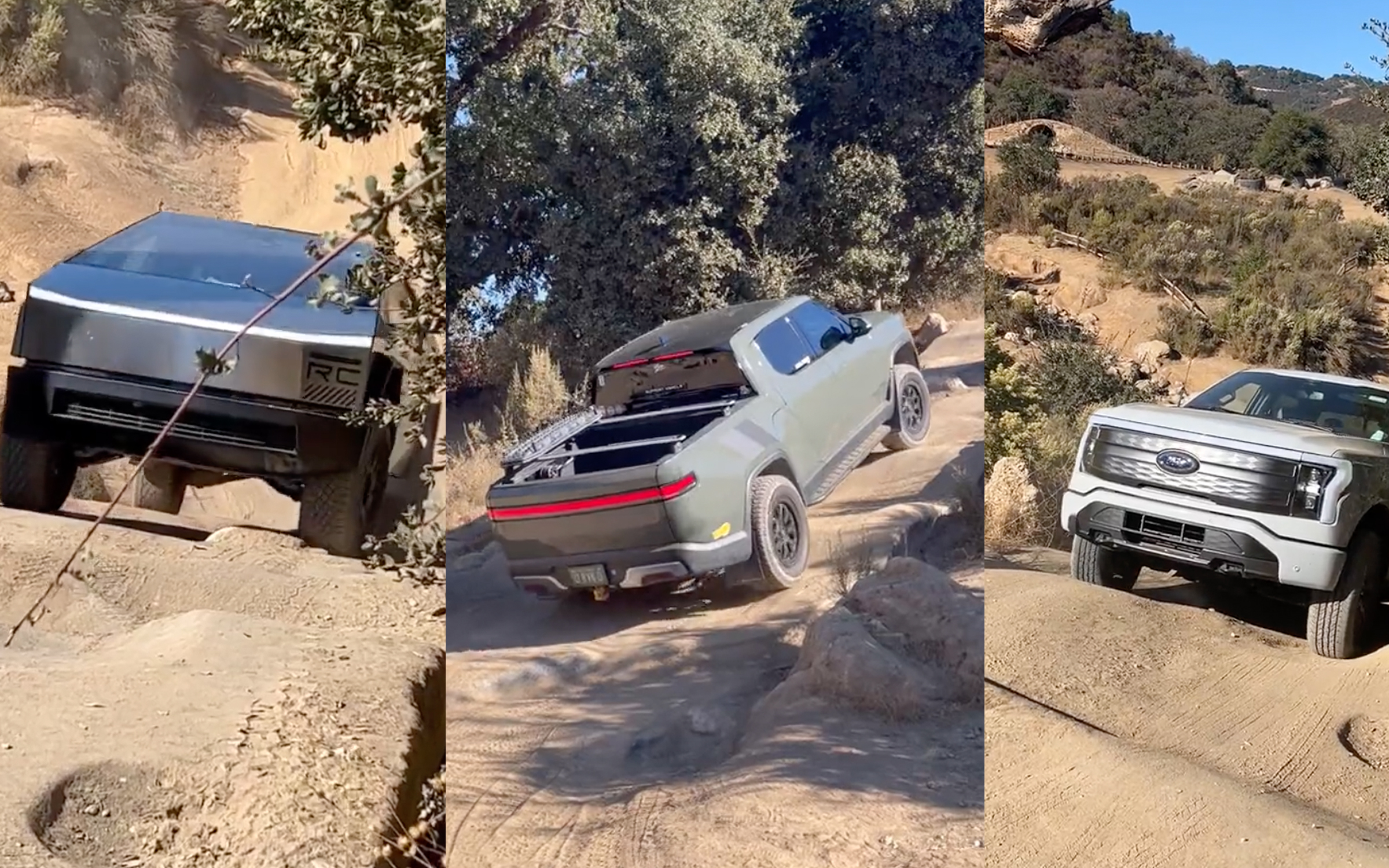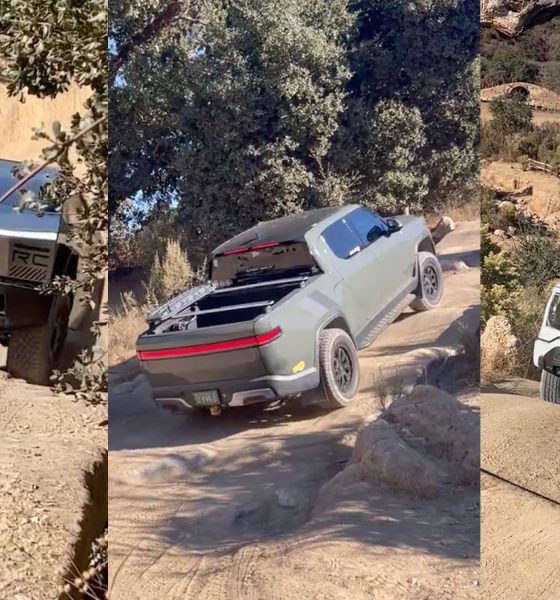

News
Cybertruck, R1T and F-150 Lightning Hollister Hills stairs runs compared
Clips of a Tesla Cybertruck climbing the stair steps at the Hollister Hills State Vehicular Recreation Area (SVRA) have circulated widely this week, especially after a Rivian R1T owner followed up with a video of their electric pickup performing the same obstacle. Now, Ford CEO Jim Farley has also chimed in, showing off footage of the same California stair steps driven by the Ford F-150 Lightning.
Multiple of Tesla’s Cybertrucks were seen during a round of testing at the SVRA site ahead of its initial deliveries later this month, as were originally spotted a few weeks ago, and shared in a post on Instagram. The R1T and F-150 Lightning attempts at the steps have since been shared on X, along with additional angles of the Cybertruck release candidate performing the obstacle.
Some have criticized the Cybertruck’s performance since the video’s release, as the R1T run seems to handle the stairs a little bit more quickly, at the very least. The F-150 Lightning also performs the stair step with some level of ease, though it’s not quite as clean of a run as the R1T footage seems to accomplish. Others have also said that a different driver could change each of these runs completely, and that an experienced off-road driver would have handled the Cybertruck’s run differently.
Tesla Cybertruck sighting next to Rivian R1T shows size comparison
It’s also worth noting that Tesla’s Cybertrucks were pre-production vehicles testing, as the trucks haven’t yet been delivered to customers at this time — and they clearly show “release candidate” decals to signify this.
User omg_Tesla, who posted the R1T footage on X, also points out that the stair step obstacle is primarily made from cement, created to offer a particularly low-traction surface to force vehicles to flex and articulate their suspension levels. The more vehicles that drive up, the user says, the more trails of dirt are left behind, making the path more slippery. A few other vehicles can also be seen driving around on the steps in the original Cybertruck footage, presumably making them more difficult during Tesla’s tests.
In any case, it’s hard to deny that all three of these pickups manage the obstacle relatively well, especially given that they’re early fully electric models in an emerging sector.
You can watch the Tesla Cybertruck, the Rivian R1T and the Ford F-150 Lightning drive on the Hollister Hills SVRA stairs below, and you can tell us your conclusions down in the comments section.
Tesla Cybertruck performing the Hollister Hills SVRA stair step
Here's another angle of the Hollister Hills climb. People thought it was a dirt hill and Cybertruck did poorly. In reality it's a lot more difficult and Cybertruck did well. pic.twitter.com/xlOIHA3pzN
— Dirty Tesla (@DirtyTesLa) November 12, 2023
Rivian R1T performing the Hollister Hills SVRA stair step
Cake walk! Tried to copy what the Cybertruck did https://t.co/t9gkJKfBXw pic.twitter.com/pBDnFw7kcw
— OMG_TESLA/RIVIAN (@omg_tesla) November 12, 2023
Ford F-150 Lightning performing the Hollister Hills SVRA stair step
F-150 Lightning does it all. 👍 pic.twitter.com/uCMUSxUIpj
— Jim Farley (@jimfarley98) November 15, 2023
What are your thoughts? Let me know at zach@teslarati.com, find me on X at @zacharyvisconti, or send your tips to us at tips@teslarati.com.

Elon Musk
Elon Musk’s X will start using a Tesla-like software update strategy
The initiative seems designed to accelerate updates to the social media platform, while maintaining maximum transparency.

Elon Musk’s social media platform X will adopt a Tesla-esque approach to software updates for its algorithm.
The initiative seems designed to accelerate updates to the social media platform, while maintaining maximum transparency.
X’s updates to its updates
As per Musk in a post on X, the social media company will be making a new algorithm to determine what organic and advertising posts are recommended to users. These updates would then be repeated every four weeks.
“We will make the new 𝕏 algorithm, including all code used to determine what organic and advertising posts are recommended to users, open source in 7 days. This will be repeated every 4 weeks, with comprehensive developer notes, to help you understand what changed,” Musk wrote in his post.
The initiative somewhat mirrors Tesla’s over-the-air update model, where vehicle software is regularly refined and pushed to users with detailed release notes. This should allow users to better understand the details of X’s every update and foster a healthy feedback loop for the social media platform.
xAI and X
X, formerly Twitter, has been acquired by Elon Musk’s artificial intelligence startup, xAI last year. Since then, xAI has seen a rapid rise in valuation. Following the company’s the company’s upsized $20 billion Series E funding round, estimates now suggest that xAI is worth tens about $230 to $235 billion. That’s several times larger than Tesla when Elon Musk received his controversial 2018 CEO Performance Award.
As per xAI, the Series E funding round attracted a diverse group of investors, including Valor Equity Partners, Stepstone Group, Fidelity Management & Research Company, Qatar Investment Authority, MGX, and Baron Capital Group, among others. Strategic partners NVIDIA and Cisco Investments also continued support for building the world’s largest GPU clusters.
News
Tesla FSD Supervised wins MotorTrend’s Best Driver Assistance Award
The decision marks a notable reversal for the publication from prior years, with judges citing major real-world improvements that pushed Tesla’s latest FSD software ahead of every competing ADAS system.

Tesla’s Full Self-Driving (Supervised) system has been named the best driver-assistance technology on the market, earning top honors at the 2026 MotorTrend Best Tech Awards.
The decision marks a notable reversal for the publication from prior years, with judges citing major real-world improvements that pushed Tesla’s latest FSD software ahead of every competing ADAS system. And it wasn’t even close.
MotorTrend reverses course
MotorTrend awarded Tesla FSD (Supervised) its 2026 Best Tech Driver Assistance title after extensive testing of the latest v14 software. The publication acknowledged that it had previously criticized earlier versions of FSD for erratic behavior and near-miss incidents, ultimately favoring rivals such as GM’s Super Cruise in earlier evaluations.
According to MotorTrend, the newest iteration of FSD resolved many of those shortcomings. Testers said v14 showed far smoother behavior in complex urban scenarios, including unprotected left turns, traffic circles, emergency vehicles, and dense city streets. While the system still requires constant driver supervision, judges concluded that no other advanced driver-assistance system currently matches its breadth of capability.
Unlike rival systems that rely on combinations of cameras, radar, lidar, and mapped highways, Tesla’s FSD operates using a camera-only approach and is capable of driving on city streets, rural roads, and freeways. MotorTrend stated that pure utility, the ability to handle nearly all road types, ultimately separated FSD from competitors like Ford BlueCruise, GM Super Cruise, and BMW’s Highway Assistant.
High cost and high capability
MotorTrend also addressed FSD’s pricing, which remains significantly higher than rival systems. Tesla currently charges $8,000 for a one-time purchase or $99 per month for a subscription, compared with far lower upfront and subscription costs from other automakers. The publication noted that the premium is justified given FSD’s unmatched scope and continuous software evolution.
Safety remained a central focus of the evaluation. While testers reported collision-free operation over thousands of miles, they noted ongoing concerns around FSD’s configurable driving modes, including options that allow aggressive driving and speeds beyond posted limits. MotorTrend emphasized that, like all Level 2 systems, FSD still depends on a fully attentive human driver at all times.
Despite those caveats, the publication concluded that Tesla’s rapid software progress fundamentally reshaped the competitive landscape. For drivers seeking the most capable hands-on driver-assistance system available today, MotorTrend concluded Tesla FSD (Supervised) now stands alone at the top.
News
Elon Musk’s Grokipedia surges to 5.6M articles, almost 79% of English Wikipedia
The explosive growth marks a major milestone for the AI-powered online encyclopedia, which was launched by Elon Musk’s xAI just months ago.

Elon Musk’s Grokipedia has grown to an impressive 5,615,201 articles as of today, closing in on 79% of the English Wikipedia’s current total of 7,119,376 articles.
The explosive growth marks a major milestone for the AI-powered online encyclopedia, which was launched by Elon Musk’s xAI just months ago. Needless to say, it would only be a matter of time before Grokipedia exceeds English Wikipedia in sheer volume.
Grokipedia’s rapid growth
xAI’s vision for Grokipedia emphasizes neutrality, while Grok’s reasoning capabilities allow for fast drafting and fact-checking. When Elon Musk announced the initiative in late September 2025, he noted that Grokipedia would be an improvement to Wikipedia because it would be designed to avoid bias.
At the time, Musk noted that Grokipedia “is a necessary step towards the xAI goal of understanding the Universe.”
Grokipedia was launched in late October, and while xAI was careful to list it only as Version 0.1 at the time, the online encyclopedia immediately earned praise. Wikipedia co-founder Larry Sanger highlighted the project’s innovative approach, noting how it leverages AI to fill knowledge gaps and enable rapid updates. Netizens also observed how Grokipedia tends to present articles in a more objective manner compared to Wikipedia, which is edited by humans.
Elon Musk’s ambitious plans
With 5,615,201 total articles, Grokipedia has now grown to almost 79% of English Wikipedia’s article base. This is incredibly quick, though Grokipedia remains text-only for now. xAI, for its part, has now updated the online encyclopedia’s iteration to v0.2.
Elon Musk has shared bold ideas for Grokipedia, including sending a record of the entire knowledge base to space as part of xAI’s mission to preserve and expand human understanding. At some point, Musk stated that Grokipedia will be renamed to Encyclopedia Galactica, and it will be sent to the cosmos.
“When Grokipedia is good enough (long way to go), we will change the name to Encyclopedia Galactica. It will be an open source distillation of all knowledge, including audio, images and video. Join xAI to help build the sci-fi version of the Library of Alexandria!” Musk wrote, adding in a later post that “Copies will be etched in stone and sent to the Moon, Mars and beyond. This time, it will not be lost.”








